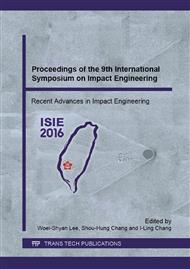[1]
H. Kaneko, K. Tobita, S. Sekiguchi, A. Muroi, Y. Hirano, Judder analysis of electronically controlled limited slip differential, JSAE Review, 17: 1 (1996) 31-36.
DOI: 10.1016/0389-4304(95)00046-1
Google Scholar
[2]
D. Centea, H. Rahnejat, M.T. Menday, Non-linear multi-body dynamic analysis for the study of clutch torsional vibrations (judder), Applied Mathematical Modelling, 25: 3 (2001) 177-192.
DOI: 10.1016/s0307-904x(00)00051-2
Google Scholar
[3]
T. -C. Li, Y. -W. Huang, J. -F. Lin, Studies on centrifugal clutch judder behavior and the design of frictional lining materials, Mechanical Systems and Signal Processing, 66-67 (2016) 811-828.
DOI: 10.1016/j.ymssp.2015.06.010
Google Scholar
[4]
Y. Tamai, T. Inazumi, K. Manabe, FE forming analysis with nonlinear friction coefficient model considering contact pressure, sliding velocity and sliding length, Journal of Materials Processing Technology, 227 (2016) 161-168.
DOI: 10.1016/j.jmatprotec.2015.08.023
Google Scholar
[5]
S. Sfarni, E. Bellenger, J. Fortin, M. Malley, Numerical and experimental study of automotive riveted clutch discs with contact pressure analysis for the prediction of facing wear, Finite Elements in Analysis and Design, 47: 2 (2011) 129-141.
DOI: 10.1016/j.finel.2010.08.007
Google Scholar
[6]
M. Pisaturo, A. Senatore, Simulation of engagement control in automotive dry-clutch and temperature field analysis through finite element model, Applied Thermal Engineering, 93: 25 (2016) 958-966.
DOI: 10.1016/j.applthermaleng.2015.10.068
Google Scholar
[7]
W. Li, J. Huang, J. Fei, L. Cao, C. Yao, Simulation and application of temperature field of carbon fabric wet clutch during engagement based on finite element analysis, International Communications in Heat and Mass Transfer, 71 (2016) 180-187.
DOI: 10.1016/j.icheatmasstransfer.2015.12.026
Google Scholar
[8]
Y. -B. Yi, S. Du, J.R. Barber, J.W. Fash, Effect of geometry on thermoelastic instability in disk brakes and clutches, ASME Journal of Tribology, 121: 4 (1999) 661-666.
DOI: 10.1115/1.2834120
Google Scholar
[9]
M. Mansouri, M. Holgerson, M.M. Khonsari, W. Aung, Thermal and dynamic characterization of wet clutch engagement with provision for drive torque, ASME Journal of Tribology, 123: 2 (2000) 313-323.
DOI: 10.1115/1.1329856
Google Scholar
[10]
M. Feng, K. Ono, K. Mimura, The FEM analysis of dry contact in the variable torque slipping clutch with skewed rollers by using weighted simplex and BFGS methods, ASME Journal of Mechanical Design, 125: 1 (2003) 186-199.
DOI: 10.1115/1.1543979
Google Scholar
[11]
C. -H. Liu, and K. -M. Lee, Dynamic modeling of damping effects in highly damped compliant fingers for applications involving contacts, ASME Journal of Dynamic Systems, Measurement and Control, 134 (2012) 011005-1-9.
DOI: 10.1115/1.4005270
Google Scholar
[12]
K. -M. Lee, C. -H. Liu, Explicit dynamic finite element analysis of an automated grasping process using highly damped compliant fingers, Computers and Mathematics with Applications, 64: 5 (2012) 965-977.
DOI: 10.1016/j.camwa.2012.02.033
Google Scholar
[13]
C. -H. Liu, W. Chen, W. Su, C. -N. Sun, Numerical and experimental analysis of the automated demolding process for PDMS microfluidic devices with high-aspect ratio micropillars, International Journal of Advanced Manufacturing Technology, 80: 1 (2015).
DOI: 10.1007/s00170-015-6959-8
Google Scholar
[14]
K.L. Johnson, Contact Mechanics, Cambridge University Press, (1985).
Google Scholar


